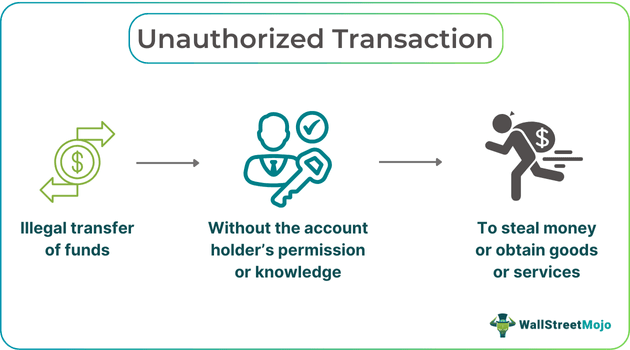Table of Contents
Key Takeaways
- Unauthorized transactions are fraudulent transactions made without the permission or knowledge of an individual, entity, or financial institution.
- They most commonly involve credit card fraud, online payment fraud, identity theft, check fraud, wire fraud, or even account takeovers.
- Simple steps to report unauthorized transactions are blocking the account or card immediately, complaining to the bank, card company,
- and federal authorities, and carefully explaining the whole incident.
- Individuals should never share their passwords, PINs, or account details, click on random links, or allow friends and family to use their account or card without their consent.
- Instead, they should check their credit reports, avoid using public networks, and only shop from reputed websites.
How To Report?
Listed below are the steps to follow to report such transactions:
- The very first thing an individual or business should do is to report them to the bank or credit card company.
- If required, try submitting a written report for the unauthorized transaction and keep a copy of the report.
- Credit card unauthorized transactions should be blocked immediately. If necessary, the bank account should also be temporarily blocked.
- Speak to the bank customer service and elaborately explain the unauthorized transaction, purchase, or any form of encountered suspicious activity.
- Reporting an unauthorized transaction may require submitting important documents; always be prepared for that.
- Constantly monitor the account once the unauthorized transaction is reported.
- It is also important to report such an incident or authorized transaction within a certain time frame; otherwise, the victim will be held responsible for the transaction. For example, deposit accounts typically have 30 days to report such unauthorized transactions.
- When an authorized transaction is reported, the federal authorities, along with the bank or financial institution, should investigate it. They have the authority to look at all angles and consider all relevant factors before arriving at the fault.
Examples
Below are two examples. The first is hypothetical, whereas the second example is from real-world news:
Example #1
Howard visits a supermarket to buy groceries. At the time of payment, he decides to pay with his credit card. A mugger, sneakily watching from behind, catches sight of Howard’s PIN. As Howard heads to the parking lot, the mugger pickpockets him, taking all the cash in the wallet along with the credit card.
When Howard arrives home, he realizes his wallet is missing. While searching, he receives a notification on his phone that a payment of $189 was just made at a shop with his credit card. The mugger, knowing Howard’s PIN, has used the card illegally, completing an unauthorized transaction without Howard's permission or awareness.
Howard immediately contacts the credit card company, his bank, and other customer support services to report the theft and requests them to block his card. He carefully reviews recent transactions and files a written complaint with the authorities. Shortly after, the mugger is caught, and the money is recovered.
Example #2
For the second example, there is the 2024 credit card fraud report and statistics. In the US, credit and debit card transactions have increased exponentially in recent years, and their security has become extremely critical as the US is working towards becoming a cashless economy. Statistics show that around 60% of US credit card holders have experienced fraud and were victims of unauthorized transactions.
In contrast, only 7% of fraudulent charges were associated with stolen or lost credit cards, while the rest involved accessing personal data and account credentials remotely. Today, four out of five US citizens possess at least one credit card, and the report shows that three of five cardholders have encountered unauthorized transactions. The general number of unauthorized transactions on debit cards or other purchases is around $100, which technically accumulates to $5 billion in criminal purchases annually.
How To Avoid It?
Steps and tips to avoid unauthorized transactions are:
- The general precaution is to keep your financial information private and confidential.
- Do not let people know your passwords and PINs, and change them from time to time.
- Do not let your friends, family, or relatives use your account or credit card without your permission or presence.
- Keep checking the transaction history from time to time to check on transactions that you have made lately.
- With Internet banking, avoid using random computers or public WIFI networks.
- Individuals should also monitor their credit reports to ensure they have no unauthorized credit in their name.
- Always carry your credit card and other crucial documents with you or leave them at home when not needed.
- Do not click on random internet links and visit suspicious sites.
- Do not give away or share account information on the Internet.
- When shopping online, buy only from trusted sites and reputed vendors.


